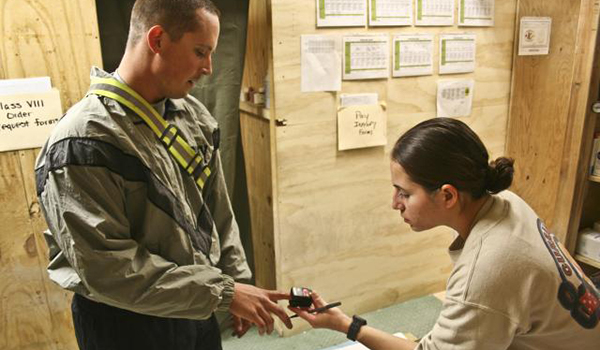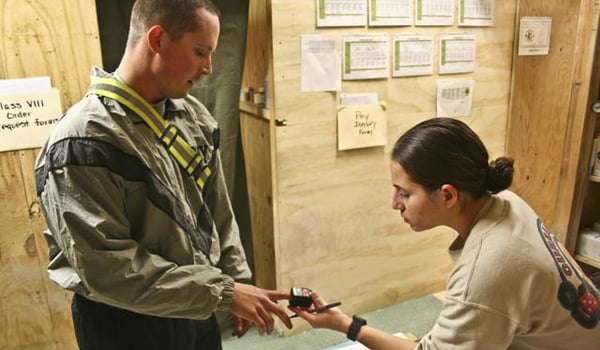
Ask the Flight Surgeon / By CPT Laura S. Ball, D.O.: Q: Recently, I have been under a lot of stress and I have been getting more frequent headaches. I wasn’t sure what I could take and keep flying. So, I haven’t been taking anything. Is there something that I can try?
FS: Headaches are very common. According to the American Academy of Family Practice, about one half of adults worldwide are affected by headaches. The symptoms of a headache can be quite varied with pain located anywhere along the head and exhibiting sharp, dull, throbbing or squeezing sensations. Some headaches are also accompanied by nausea, vomiting, sensitivity to light or sound, watering of the eyes and restlessness or agitation. The concern in aviation is that these symptoms can be distracting or even disabling which can negatively impact safety of flight and successful mission accomplishment.

One of the leading injuries the medics at the station say they see are traumatic brain injuries. (Photo Credit: Staff Sgt. Ryan C. Matson)
The accompanying symptoms and the location of the pain are used in the diagnosis of headaches and to determine if the pain is a sign of a more serious condition. When it comes to headaches, there are some concerning findings that are considered “red flags” and require a thorough assessment. These red flags may include recent trauma such as found in a motor vehicle accident, confusion or personality changes and new headaches that start after fifty years of age. Also of concern are headaches that have been increasing in frequency or severity, are accompanied by fever or stiff neck, difficulty speaking, limb weakness, numbness or tingling. Though relatively uncommon, some headaches can be the sign of a life threatening condition, such as when you have a sudden onset of a severe headache that is often described as the worst headache of one’s life and hits like a “thunderclap.”
In the absence of other underlying causes, headaches are considered “primary” and are typically classified as migraine, tension type or cluster headaches. Migraines are headaches that last for 4 to 72 hours with moderate to severe, one-sided pain made worse with activity and accompanied by nausea, vomiting, and/or sensitivity to light or sound. Some people who suffer with migraine headaches also experience “auras” that usually precede the headache and last less than one hour. Auras might be experienced as numbness or tingling in a body part (sensory), muscle weakness (motor), difficulty with speech (verbal), or visual. Visual auras are the most common type of auras and are often described as bright spots or flashes, sickle or C-shaped objects or zig zag lines in the field of vision or even temporary vision loss. These auras would also be considered red flags and should be fully evaluated by your flight surgeon. Some people are able to identify specific triggers that cause migraines. One of the most common migraine headache triggers is stress. There are medications available, both prescription and over the counter, to treat migraines, but the best treatment option is prevention of identified triggers.
Tension type headaches can last anywhere from 30 minutes to seven days. The typical pain from these headaches is mild to moderate in severity and is located on both sides of the head. It is described as tightening or a pressing pain. An important feature is that these headaches are not accompanied by nausea, vomiting, light sensitivity or sound sensitivity, and they are not made worse by physical activity. These headaches are thought to be caused by over sensitization of pain sensors in the head and neck, and stress may be a contributing factor. Treatment can include not only medications but also biofeedback therapy, cognitive behavioral therapy and relaxation techniques.
Cluster headaches are commonly located on one side of the head and often localize around the eye. They can last 15 to 180 minutes and are accompanied by watering and redness of the eye, swelling of the eye lid, runny nose or congestion, sweating of the face and changes in pupil size – all on the same side as the pain. Also, these headaches may be accompanied by restlessness and agitation. It can be difficult to treat this type of headache, though there are some treatments available, and the exact cause is not known.
However, most headaches have a known cause such as excessive alcohol consumption, dehydration, the common cold, sinus problems, flu, caffeine withdrawal and some medications. For these headaches, barring any of the aforementioned red flags, it is aeromedically permissible to take a dose of an over-the-counter medication such as acetaminophen (Tylenol), ibuprofen (Advil), naproxen (Aleve) or aspirin for adequate relief. Chronic or severe headaches such as migraine, tension-type and cluster headaches, in contrast, need to be evaluated by your flight surgeon to optimize treatment. Your flight surgeon can discuss several therapeutic approaches, including flight approved medications as well as non-medication options such as physical therapy, relaxation techniques, biofeedback and lifestyle changes. Although chronic headaches require a waiver, don’t let that deter you from seeing your flight surgeon as most waivers for chronic waivers are approved when successfully treated.
Fly Safe! — Dr. Ball
Question for the Flight Surgeon?
If you have a question you would like addressed, email it to This email address is being protected from spambots. You need JavaScript enabled to view it.; we’ll try to address it in the future. See your unit flight surgeon for your personal health issues.The views and opinions offered are those of the author and researchers and should not be construed as an official Department of the Army position unless otherwise stated.
CPT (Dr.) Laura Ball is a flight surgeon at the U.S. Army School of Aviation Medicine, Fort Rucker, AL.







